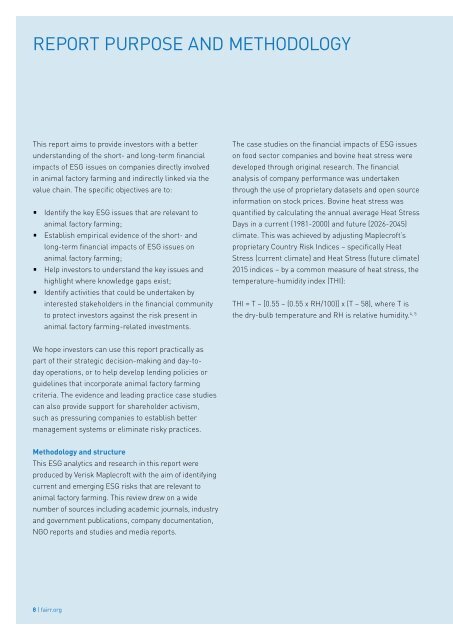FACTORY FARMING
1M2uJRn
1M2uJRn
Create successful ePaper yourself
Turn your PDF publications into a flip-book with our unique Google optimized e-Paper software.
REPORT PURPOSE AND METHODOLOGY<br />
CONTENTS<br />
This report aims to provide investors with a better<br />
understanding of the short- and long-term financial<br />
impacts of ESG issues on companies directly involved<br />
in animal factory farming and indirectly linked via the<br />
value chain. The specific objectives are to:<br />
The case studies on the financial impacts of ESG issues<br />
on food sector companies and bovine heat stress were<br />
developed through original research. The financial<br />
analysis of company performance was undertaken<br />
through the use of proprietary datasets and open source<br />
Key findings 2<br />
Foreword from FAIRR Founder 3<br />
EXECUTIVE SUMMARY 4<br />
CHAPTER 4: IMPLICATIONS AND<br />
NEXT STEPS 45<br />
4.1 Overview 45<br />
4.2 Implications of the findings for investors 45<br />
••<br />
Identify the key ESG issues that are relevant to<br />
animal factory farming;<br />
••<br />
Establish empirical evidence of the short- and<br />
long-term financial impacts of ESG issues on<br />
information on stock prices. Bovine heat stress was<br />
quantified by calculating the annual average Heat Stress<br />
Days in a current (1981-2000) and future (2026-2045)<br />
climate. This was achieved by adjusting Maplecroft’s<br />
proprietary Country Risk Indices – specifically Heat<br />
CHAPTER 1: CONTEXT – PUTTING ALL<br />
OUR EGGS IN ONE BASKET 10<br />
1.1 Overview 10<br />
4.3 Next steps 46<br />
APPENDIX 48<br />
animal factory farming;<br />
••<br />
Help investors to understand the key issues and<br />
highlight where knowledge gaps exist;<br />
Stress (current climate) and Heat Stress (future climate)<br />
2015 indices – by a common measure of heat stress, the<br />
temperature-humidity index (THI):<br />
1.2 The development and geographical<br />
expansion of animal factory farming 11<br />
LIST OF FIGURES AND TABLES<br />
Figure 1: A new phenomenon. Graph shows the rapid<br />
••<br />
Identify activities that could be undertaken by<br />
1.3 Limited information has created a<br />
increase in the global production of main livestock species<br />
interested stakeholders in the financial community<br />
THI = T – [0.55 – (0.55 x RH/100)] x (T – 58), where T is<br />
dangerous knowledge gap for investors 12<br />
compared to human population growth (1963–2013).<br />
to protect investors against the risk present in<br />
animal factory farming-related investments.<br />
We hope investors can use this report practically as<br />
the dry-bulb temperature and RH is relative humidity. 4, 5<br />
CHAPTER 2: 28 ESG ISSUES AND<br />
THEIR IMPACTS 15<br />
Figure 2: ESG issues as drivers of financial performance<br />
within the context of animal factory farming.<br />
Figure 3: Future heat stress and impacts on key cattle<br />
part of their strategic decision-making and day-to-<br />
2.1 Overview 15<br />
producing countries<br />
day operations, or to help develop lending policies or<br />
guidelines that incorporate animal factory farming<br />
criteria. The evidence and leading practice case studies<br />
2.2 From pandemics to pollution, a wide range<br />
of ESG issues affect key financial levers 15<br />
Figure 4: Financial impact of food safety scandal to<br />
fast-food chains in 2014<br />
can also provide support for shareholder activism,<br />
2.3 Environmental issues and impacts 17<br />
Figure 5: US pork producers see share prices plummet<br />
such as pressuring companies to establish better<br />
management systems or eliminate risky practices.<br />
Methodology and structure<br />
2.4 Social issues and impacts 24<br />
2.5 Governance issues and impacts 32<br />
following swine flu outbreak, Apr 2009<br />
Figure 6: Major Asian poultry firms see share price<br />
declines during avian influenza outbreak, 2013<br />
This ESG analytics and research in this report were<br />
produced by Verisk Maplecroft with the aim of identifying<br />
current and emerging ESG risks that are relevant to<br />
animal factory farming. This review drew on a wide<br />
number of sources including academic journals, industry<br />
CHAPTER 3: INTEGRATING ANIMAL<br />
<strong>FACTORY</strong> <strong>FARMING</strong> RISKS INTO<br />
INVESTMENT PROCESSES 35<br />
3.1 Overview 35<br />
Table 1: ESG issues that may have an adverse impact<br />
on financial performance and returns from animal<br />
factory farming<br />
Table 2: Key environmental issues<br />
and government publications, company documentation,<br />
NGO reports and studies and media reports.<br />
3.2 Investing in food and agriculture 35<br />
3.3 Integrating animal factory farming risks<br />
Table 3: Key social issues<br />
Table 4: Key governance issues<br />
into investment processes 36<br />
Table 5: Integrating ESG issues into equity research<br />
3.4 Integrating farm animal welfare<br />
opportunities into investment decisions 42<br />
8 | fairr.org<br />
fairr.org | 9


